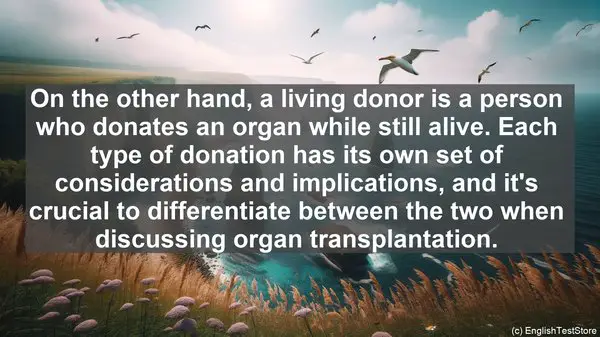Introduction
Today, we’re going to dive into the fascinating world of organ transplantation. But before we get into the nitty-gritty details, it’s crucial to have a solid grasp of the terminology used in this field. Words can often be confusing, and in a specialized area like organ transplantation, this confusion can lead to serious misunderstandings. So, let’s explore the top 10 commonly confused words and ensure that we’re on the same page when it comes to discussing this life-saving procedure.
1. Donor vs. Recipient
One of the fundamental concepts in organ transplantation is the differentiation between the donor and the recipient. The donor is the individual who generously provides the organ, either through a living donation or posthumously. On the other hand, the recipient is the person who receives the organ. While it may seem obvious, these terms are sometimes used interchangeably, leading to confusion in discussions and medical records.
2. Graft vs. Host
When a transplanted organ is introduced into a recipient’s body, it’s referred to as a graft. Now, here’s where the confusion arises. In some cases, the recipient’s immune system may recognize the graft as foreign and mount an immune response. This is known as graft rejection. On the other hand, when the transplanted organ’s immune cells attack the recipient’s body, it’s called a host response. So, remember, graft rejection is the recipient’s immune system rejecting the organ, while a host response is the transplanted organ attacking the recipient’s body.
3. Immunosuppressant vs. Immune Stimulant
To prevent graft rejection, patients undergoing organ transplantation are often prescribed immunosuppressant medications. These drugs work by suppressing the recipient’s immune system, reducing the chances of rejection. However, in certain situations, such as when a patient is dealing with an infection, immune stimulant medications may be administered. These drugs, as the name suggests, stimulate the immune system, helping the body fight off the infection. So, while immunosuppressants dampen the immune response, immune stimulants enhance it.
4. Ischemia vs. Reperfusion
During the process of organ transplantation, there are two critical phases: ischemia and reperfusion. Ischemia refers to the period when the organ is not receiving an adequate blood supply. This can occur during organ procurement or when the transplanted organ’s blood vessels are being connected. Reperfusion, on the other hand, is when the blood flow is restored to the organ. Both these phases can have significant implications for the organ’s viability and function, making it essential to carefully manage them during the transplantation process.
5. Cadaveric vs. Living Donor
Organ donors can be broadly classified into two categories: cadaveric and living donors. A cadaveric donor is an individual who has passed away, and their organs are donated for transplantation. On the other hand, a living donor is a person who donates an organ while still alive. Each type of donation has its own set of considerations and implications, and it’s crucial to differentiate between the two when discussing organ transplantation.
6. Isograft vs. Allograft
When it comes to the source of the transplanted organ, there are two main types: isografts and allografts. An isograft, also known as an autograft, is a transplant where the organ is taken from one part of the patient’s body and transplanted to another. Since the organ is from the same individual, the chances of rejection are minimal. On the other hand, an allograft involves the transplantation of an organ from one individual to another, often from a cadaveric or living donor. Allografts carry a higher risk of rejection and require careful monitoring.
7. Indication vs. Contraindication
In the context of organ transplantation, an indication refers to a specific medical condition or situation where a transplant is considered appropriate. For example, end-stage organ failure might be an indication for transplantation. On the other hand, a contraindication is a factor that makes a transplant inadvisable or risky. For instance, an active infection might be a contraindication for transplantation. Understanding these terms is crucial for determining the suitability of a patient for transplantation.
8. Cold Ischemia Time vs. Warm Ischemia Time
During the transplantation process, there are two types of ischemia times to consider: cold and warm. Cold ischemia time refers to the duration when the organ is preserved at a low temperature, often in a solution, to maintain its viability. This is typically done during transport or when the organ is being prepared for transplantation. Warm ischemia time, on the other hand, is the period when the organ is without a blood supply but is at body temperature. This can occur during the surgical removal of the organ or when the blood vessels are being connected. Both these times need to be minimized to ensure optimal organ function post-transplant.

9. Primary vs. Secondary Transplantation
In some cases, a transplanted organ may not function optimally or may be rejected. In such situations, a secondary transplantation might be considered. Primary transplantation refers to the first instance when the organ is transplanted into a recipient. Secondary transplantation, on the other hand, is when the organ is re-transplanted into another recipient. The success rates and outcomes of secondary transplantation can vary and depend on various factors, including the reason for the initial graft failure.

10. HLA Matching
Human leukocyte antigen (HLA) matching is an important consideration in organ transplantation. HLA molecules play a crucial role in the immune response, and a closer match between the donor and recipient HLA types can reduce the risk of rejection. HLA matching is particularly important in allograft transplantation, where the organ is from a different individual. Various HLA typing tests are performed to determine the compatibility between the donor and recipient, aiding in the decision-making process for transplantation.
